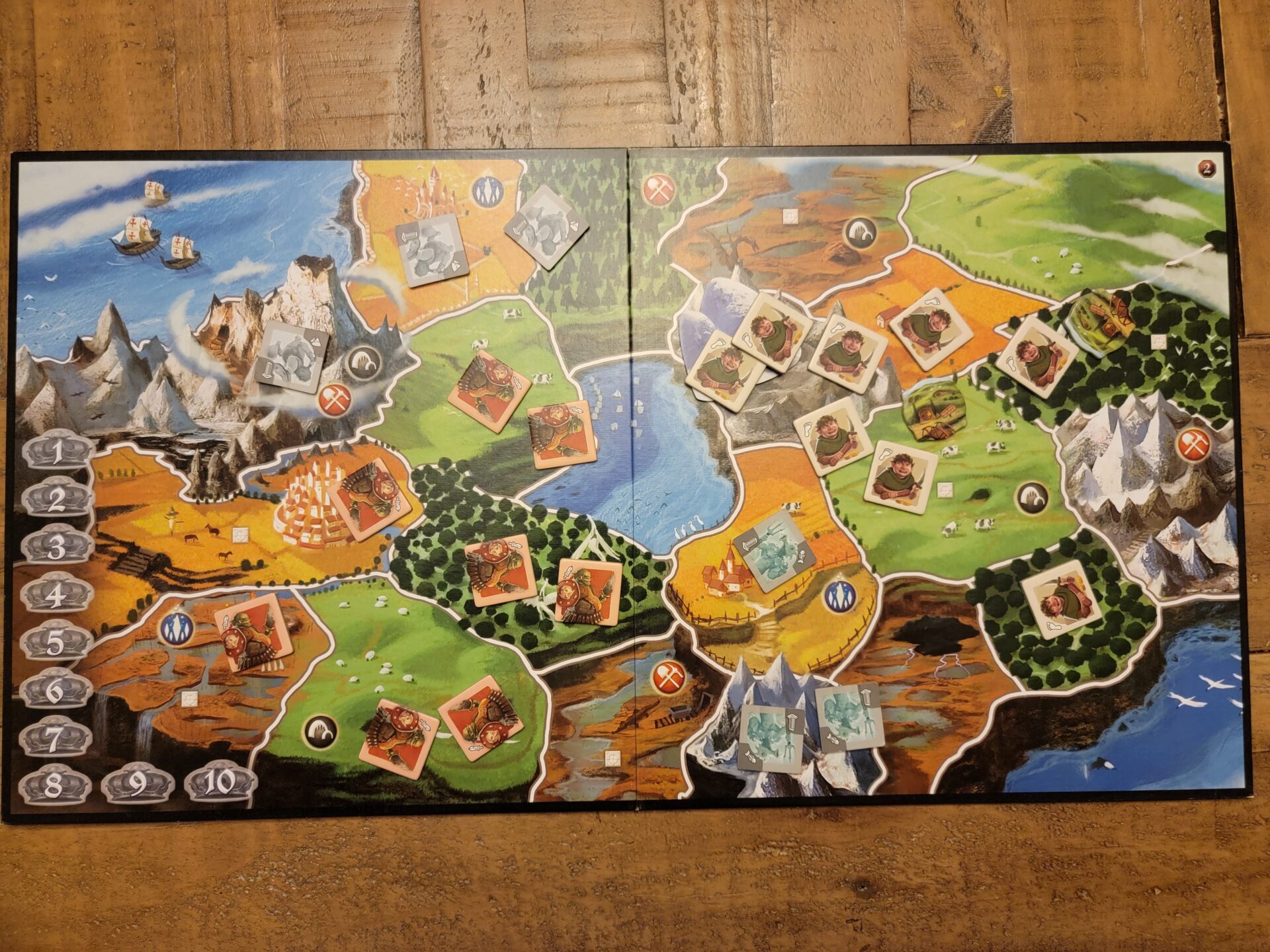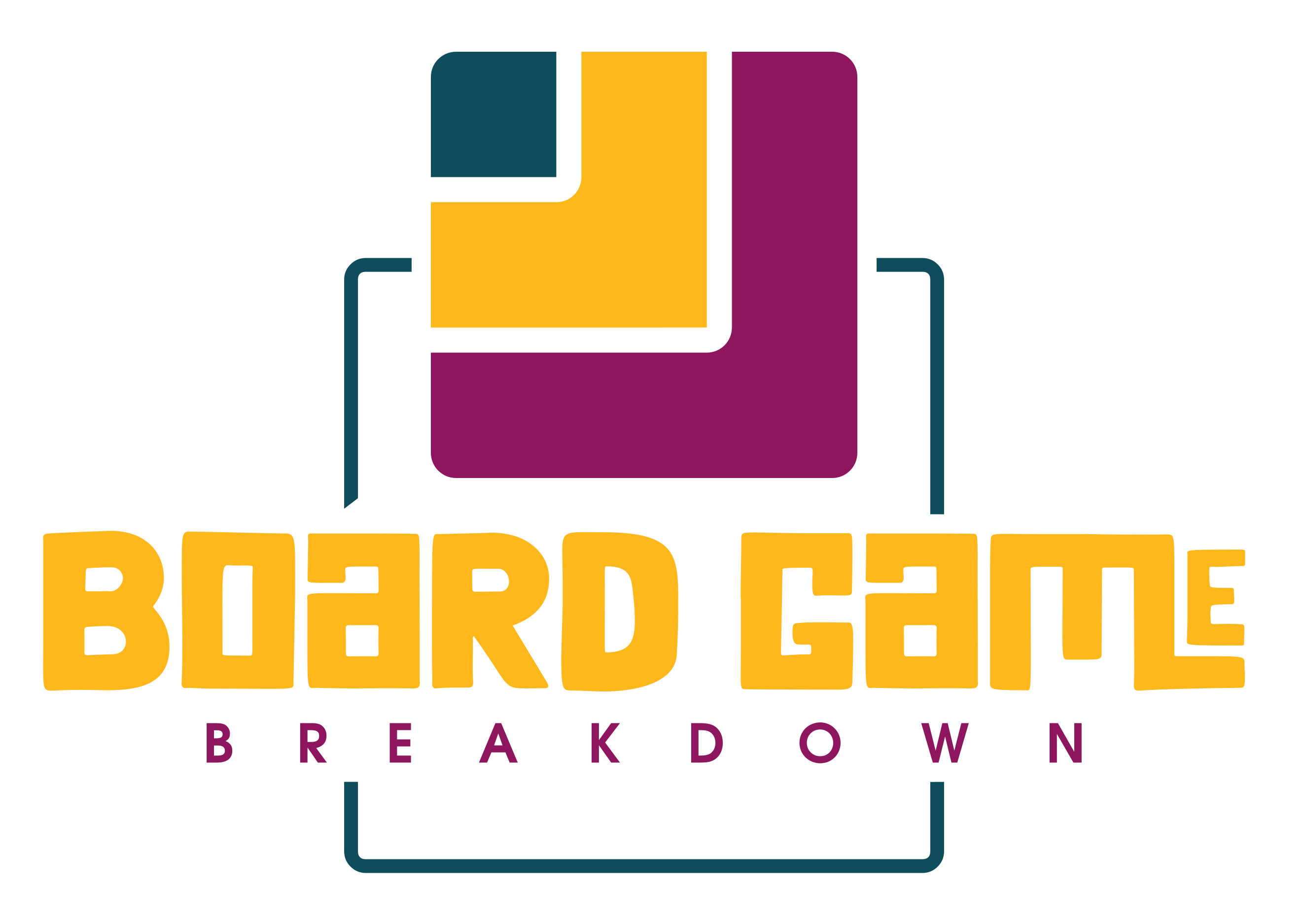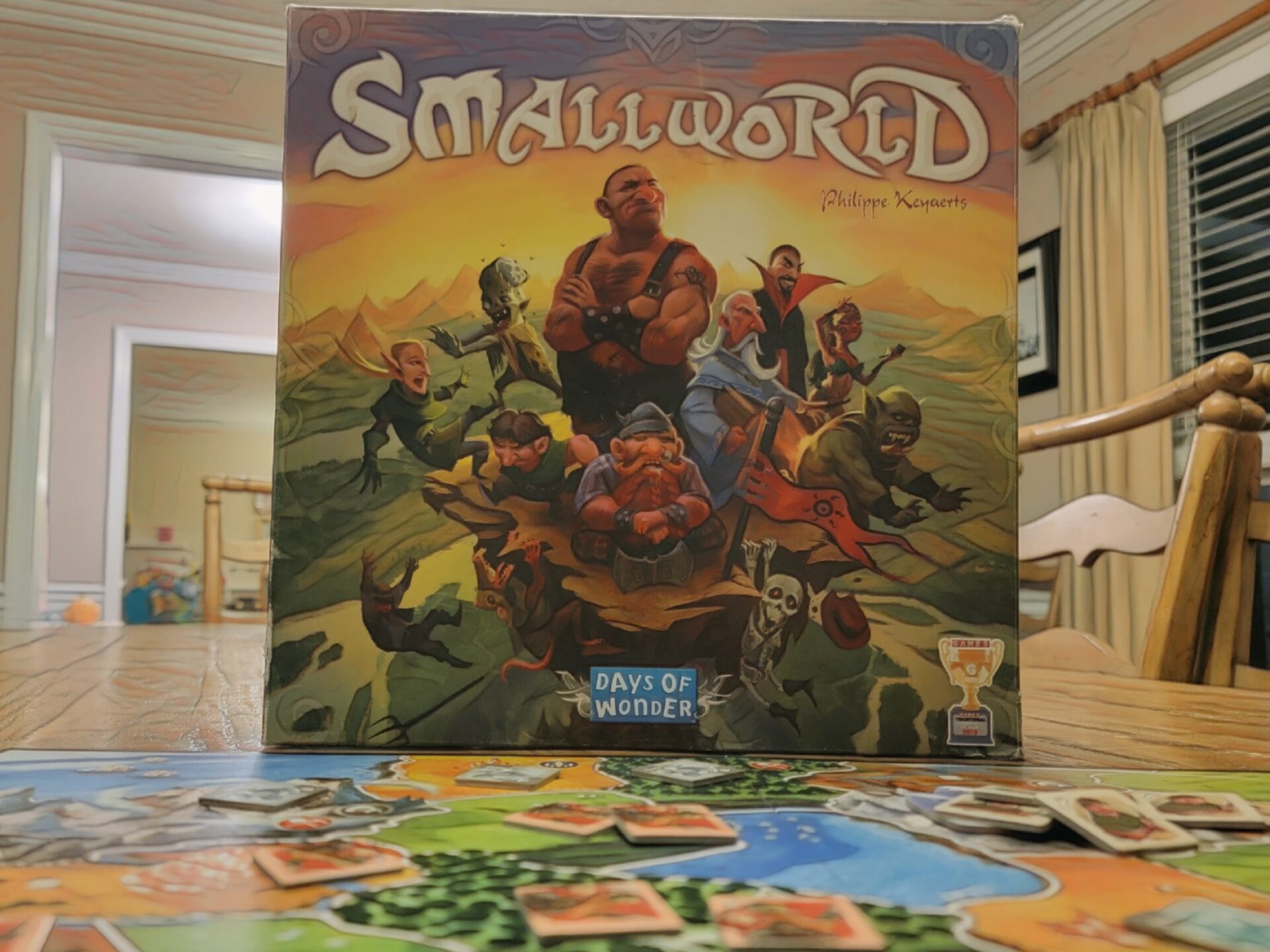
Name: Small World
Year of Release: 2012
Player Count: 2 – 5 Players
Playing Time: 40 – 80 minutes
Designer: Philippe Keyaerts
Publisher: Days of Wonder
Primary Mechanisms: Area Majority, Variable Player Powers, Area Movement
Weight (According to boardgamegeek.com): 2.35
This review is a part of the Retrospective Review series where Board Game Breakdown takes a look back at games that were released at least 10 years ago. We will highlight aspects of the game that still work for us after all this time and then the aspects that haven’t lived up to the feelings we had originally. This will all culminate in our normal rating structure at the end of the review.
Introduction
Depending on when a player got into the modern board game hobby, there seems to just be certain “gateway” titles that everyone tried, if not outright owned. For me, I’m thinking of Catan, Ticket to Ride, Dominion, and of course, Small World. Looking back at the historical ranks on Boardgamegeek.com, Small World debuted in the mid-thirties, and never even fell out of the top 100 until early 2015. Even at the time of this writing, nearing the end of 2022, it sits barely out of the top 300.
Personally, I used to play this game weekly, with mostly my wife, and sometimes with a larger group. But at some point in the past six years, it has been relegated to a cabinet where the older games tend to live. When I first dreamed up this series, Small World was the first game to come to mind, but I ended up writing about Lords of Waterdeep first. Over the past few weeks, I broke Small World back out to get in a few rounds (and even taught it to my kids) to see how I felt about this gem of a game, thirteen years from its initial release.
Game Overview

Let’s get it out of the way early: yes, I will probably use the game Risk as some sort of comparison to Small World. No, I don’t think they are all that much alike, but I do think that Risk is typically one of the earliest examples of an area control game that one might play, and it can be a good measuring stick for players who don’t have much experience with modern board games.
Like Risk, the point of Small World is to conquer regions spread out over a map to obtain Victory Point Coins. Players will do this by putting a necessary amount of Race Tokens into a region to show that they then have control over it. Typically, a player needs two tokens per region, plus an additional token for every other token that might already be there, such as opponent Race Tokens, or defensive game pieces like Troll Lairs or Fortresses.
Unlike Risk, there is (almost) no use of a die and the defender has no way to actually defend their position. Another difference from Risk (and this is the huge one) is that each player uses a different combination of Races and Special Power Badges from their opponent. This aspect makes the game quite asymmetrical as well as varied from game to game. There is also an added mechanism to change races, but I will get into that more, further in the review. At the end of each player’s turn, they are awarded as many Victory Point Coins as regions they control, and then it is the next player’s turn. After eight to ten rounds, depending on player count, the player with the most Victory Coins wins.
What Works – Varied Race Tokens and Special Power Badges

I’m not sure if the following statement can be confirmed as fact, backed up by empirical data, but anecdotally, it rings true: everyone loves variable player powers. If you’re one of those people (and let’s face it, you are since the whole “everyone” thing), then Small World was made for you. There are 14 Race Banners, all carrying their own unique powers, that are then coupled up with 20 different Special Power Badges that each contain an additional power. If I remember correctly how to come up with a total number of combinations, this is a potential 280 different combinations of races and special powers. If I’m wrong on that, please pretend that you read it incorrectly to spare me some embarrassment.
Needless to say, 280 is a lot of variation and that is bound to keep players busy. Sure, some of the Special Power Badges are on the “lame” side of things (I’m looking at you, Alchemist Badge) but overall, they are fun and help add some direction to your turns. Some of the badges (such as Bivouacking) allow you to place down defense tiles, boosting the number of tiles your opponent will need to conquer that region. Others (such as Seafaring) allow you to conquer bodies of water which are typically out of reach for other race combinations.
If you are unlucky enough to have a not-so-cool Special Power, your race’s unique power is there to brighten up your day, unless you’re the Humans… boring! Whenever I play, I’m always struck by the creativity the designer put into the different races. My favorites include the Sorcerers who allow you to “swap” out an opponent’s tile that has been left alone in a region for another Sorcerer token from the supply. In this way, it is as if you are able to cast a spell and transform a rival army into one of your trusty Sorcerers. Elsewhere, you have the Amazons who gain an extra four army tiles when on the offensive but must put them back when they are playing defense. Lastly, I like the Tritons that allow you to pay one less token anytime they are in a region bordering a body of water. Just the variation between these three should give you an idea of the swath of powers that the game spans.
What Works – Decision to Decline
As much as I love variable player powers, I think the Decline mechanism is the star of the show here, differing wildly from anything employed in area control games that I’ve seen, especially in 2009. The importance of this mechanism becomes fairly obvious by your second or third turn, depending on your race. Basically, outside of some special race abilities, a player will never gain more race tiles to deploy. If you’ve ever played Inis, you know that as that game moves forward, you’re hoping to gain more tribes so you’re able to spread out while also defending your current territories. Small World is the opposite. A player is going to quickly spread themselves thin, finding out that they are very limited in their options to continue to surge forward through the map.
When a player determines that they have gotten all they can out of their current race, they put it into Decline. This means that for that one turn, they forfeit the ability to conquer anymore regions and instead, remove all race tiles (except one) from each region. Those that are left are flipped over to show the greyscale side so that all other players know that the race is in decline. As usual, the player gains a coin for each region that the Declined race occupies and then the turn is over. On their next turn, the player drafts a new Race Banner / Special Power Badge combination, grabs the correct number of the new race’s tiles, and then comes onto the board from an edge as if they are starting the game for the first time. From here on, the player will score points for all the regions they occupy using both the Declined race and the active race. Typically, all special powers of the Declined race will deactivate once they are put into Decline, so the tiles are mostly just placeholders to award the player points. If the player ever has to put another race into Decline, the original race’s tiles are removed altogether as each player can only have two races on the board at once.
You can probably see that this has the potential to create many interesting decision points. When is the right moment to put a race in Decline? Will you ride it out to the last possible second? Or maybe it’s better to exploit the special abilities for one turn and then put it into Decline to get a jump on another powerful combination before any other opponents can beat you to it? This is just a really fun and creative mechanic that I never tire of.
What Works – Game Length / Pace of Game

I’ve always enjoyed the pace of Small World, especially if playing with seasoned vets. Turns are about as streamlined as you can get: scoop up all your race tiles, except one in each region; start deploying them across the map until you’re out; reinforce (meaning you have a chance to re-arrange how many tiles are on each region); collect Victory Point coins and you’re done. There might be a few other adjustments depending on your special powers but for the most part, a turn occurs pretty rapidly.
I’ve also never experienced much Analysis Paralysis while playing. It’s not one of those games where you’re stuck with a flowchart of decisions to make, trying to mix/max every single facet of the game. The pace keeps the game moving and most games, at least at lower player counts, can be completed in 45 minutes, a perfect sweet spot for a game of this weight.
What Doesn’t Work – Scaling at Larger Player Counts
I mentioned in the introduction, the majority of my plays of Small World were at the two or three player count and this is where I think the game shines. On the other hand, my experiences with this game at four or five players tends to be a jumbled mess. Maybe that’s being too harsh, but it definitely feels more like a “party” game than a strategy game. Even at lower counts, the game tends to be more tactical than strategical but as players are added, you’re forced to just roll with the punches and hope for the best. At five players, players win and lose almost by sheer luck instead of because of any meaningful decisions they made. Again, this is solely based on my experiences, and I can understand that they may differ from the experiences of certain readers. Honestly, this isn’t even that bad of a point in that I think this game is amazing at two and three players, I just think it should be known that it plays wildly different at four and five counts.
What Doesn’t Work – Absence of Hidden Information
What I think Small World is missing the most is some sort of hidden information. I mentioned the game Inis earlier and I’d like to take some inspiration from that game for a minute. As you decide what regions to conquer, you can see how many tribes your opponent has on the region, and you can obviously see how many tribes that you are allowed to move into the region in order to take it over. What you can’t see though is the deck of cards your opponent holds. Some of the cards you will be aware of (because of how the drafting system in that game works) but there will be some that are still a mystery. Because of this fact, you’re never quite sure how a conquering campaign will work out.
In Small World, all information is plainly laid out on the table, and this can turn the game into somewhat of a mechanical, mathematical exercise. My opponent can see that I only have six tiles to use this turn to conquer. She also can see my special powers and knows that I have none that will help me lessen the tiles I need to deploy. We can both see that there are only two territories around me that have the right amount of opponent tiles to be conquered. So, it’s basically conquer those and end my turn or go into Decline with my current race. This lack of hidden information seems to lessen some of the tension that one would want in a game about smashing opponents to smithereens and taking their land for your own.
Conclusion

I had honestly forgotten how much I enjoyed Small World till I started playing it again in preparation for this retrospective. Maybe it’s partly nostalgia but I really think this game holds up after all this time and a whole lot of plays. I’d encourage anyone who hasn’t played Small World to take up the banner of the Pillaging Orcs or the Flying Giants, grab one or two friends to join you, and try out this stellar game.
Rating
Ratings are based on 5 main criteria: rulebook, setup, components, art & graphic design, and gameplay. The first 4 criteria are rated 1 to 5 and the gameplay is rated 1 to 10. These scores culminate in an “overall satisfaction” score that is rated from 1 to 10. If the reviewed game has both a solo and multiplayer mode, I have assigned scores separately to give context to which mode we enjoy more.
Links
As an Amazon Associate I earn from qualifying purchases.
Amazon: Small World Board Game

